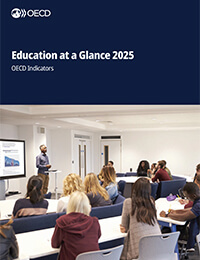The latest Education at a Glance report from The Organization for Economic Cooperation and Development (OECD) offers an unsettling portrait of the United States. Once a global leader in higher education, the country now finds itself spending more than nearly any of its peer nations while delivering outcomes that fall increasingly short. American students are less likely to complete college on time, and more likely to leave school burdened by debt without a degree. They are navigating a system that continues to promise opportunity while too often failing to deliver it in practice.
If we want to reverse this trend, we have to treat education not as a patchwork of disconnected stages, but as a continuous journey that demands investment, planning, and care at every level. That begins with early reading and numeracy instruction, long before students consider college. It includes a serious reevaluation of how we structure, support, and fund higher education. It requires stronger links between schools, colleges, and the labor market, so that students are better prepared not only to graduate but to succeed beyond the classroom.
This is not merely a technical failing or an academic quibble. It is a clear warning that the United States is struggling to produce the skilled, educated workforce it needs to sustain its economy, to strengthen its communities, and to remain globally competitive. And the challenges we face in higher education cannot be understood in isolation, because the problem begins much earlier.
Just weeks ago, the National Assessment of Educational Progress released its 2024 results, and the findings should alarm anyone who cares about the future of American education. Twelfth-grade reading and math scores have declined again, continuing a downward trajectory that began well before the disruptions of the pandemic. In eighth grade, one in three students now performs below the basic level in reading, which means that a significant share of American adolescents are struggling with tasks as fundamental as understanding main ideas or identifying supporting evidence. These are not isolated problems affecting a small subset of students. They are widespread and persistent, and they indicate deep structural weaknesses in the foundation of our education system.
Many American students are arriving at college underprepared for the demands they will face. Colleges are then expected to compensate for years of educational inequities and shortfalls, but they often lack the resources, the coordination, or the incentives to do so effectively. The result is a system that prides itself on broad access but fails to support student success. Large numbers of students begin college only to drop out partway through, accumulating debt without earning the credentials that would help them pay it off or advance in the labor market.
The OECD report makes clear that the United States has pursued access to higher education without ensuring the structures are in place to help students thrive once they arrive. While we spend more per student than most countries and devote a higher percentage of our GDP to education, our college completion rates remain stubbornly low. The system is leaking talent, and we are doing far too little to plug the holes.
There is also growing evidence of a disconnect between what students study and what the economy demands. The report highlights wide disparities in the labor market returns of different fields of study. Students often lack the guidance and information needed to choose paths that align with both their interests and future opportunities. Many end up with degrees that do not provide a clear route to employment or advancement, while employers in key sectors struggle to fill roles requiring specialized training. This misalignment is not the fault of individual students. It is the result of a system that lacks coordination, accountability, and strategic foresight.
What both the OECD and NAEP reports show, taken together, is a system that is not only under strain but in many ways adrift. Foundational skills are not being reliably taught in the early grades. High schools are not closing the gaps. Colleges are not sufficiently supporting students who enter already at a disadvantage. And the labor market is not matched with the graduates it needs. We are not facing a single crisis but a series of overlapping failures that reinforce one another and compound over time.
These are not abstract policy problems. They affect every aspect of American life. A weaker education system means slower economic growth, greater inequality, and diminished prospects for innovation. Regions without skilled workers struggle to attract investment. Families without educational opportunity struggle to climb the economic ladder. A country that cannot educate its people cannot lead in science, in health care, in technology, or in democratic renewal.
The numbers are no longer surprising. The patterns have been visible for years. What is missing is the political and institutional will to act. If we continue to allow these declines to accelerate, we will face a future in which too many Americans are denied the education they need and the country is denied the talent it requires.
This requires urgency, but it is not inevitable. We still can choose a different path. But that choice must be made now, before the slide becomes a fall, and before the costs of inaction become irreversible.

